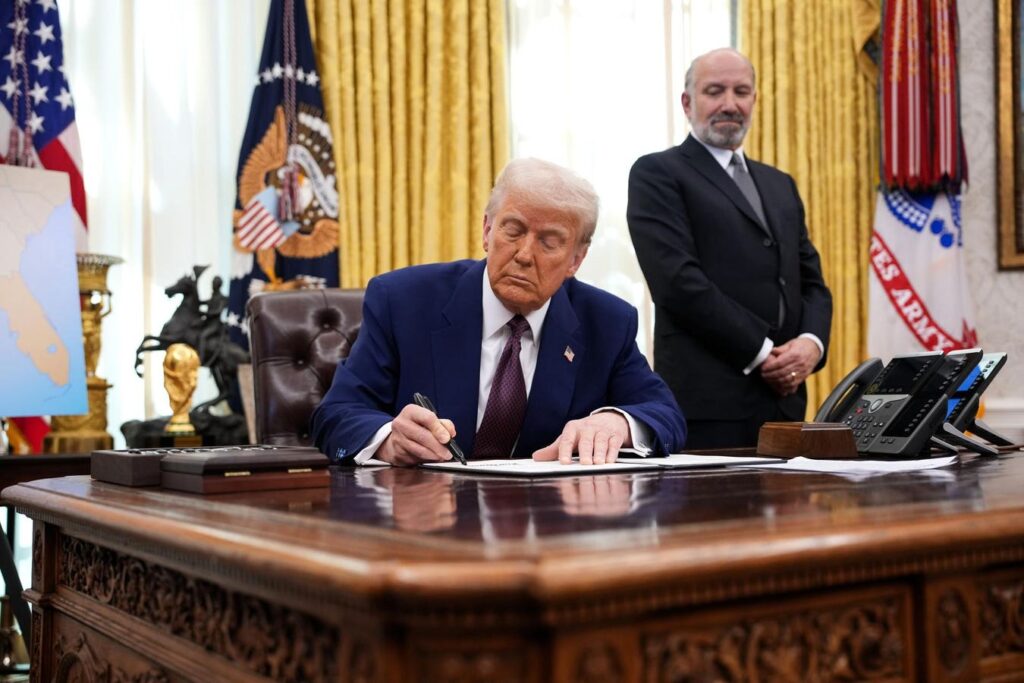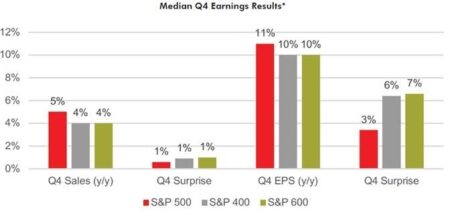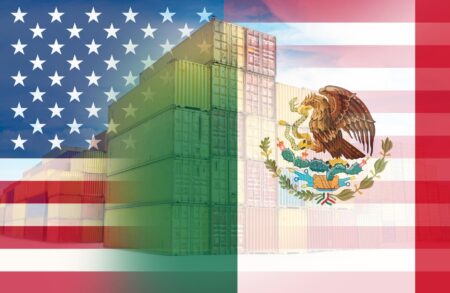The direction of President Donald Trump’s tariff strategy is becoming clearer. The idea of universal tariffs, where all imports are taxed at the same punitive rate, has been abandoned. Instead, the administration has opted for reciprocal tariffs, in which the U.S. matches the import duties levied by other countries. For example, if a country taxes cars made in the U.S. at a rate of 10%, the U.S. will impose the same 10% tax on cars imported from that country. This shift is welcome news for investors, U.S. consumers, and trading partners. As with most changes to international trade policy, the details are complex, and there will be both winners and losers.
The February 13 White House memorandum details a plan to consider tariffs on trading partners, value-added taxes, and non-tariff barriers to trade, such as regulatory requirements, subsidies, and exchange rate policies. In the memorandum, Trump ordered officials to include in their tariff calculations “any other practice that” they conclude “imposes any unfair limitation on market access or any structural impediment to fair competition with the market economy of the United States.” In other words, each trading relationship will be examined in its entirety. Trump has asked his team to gather all this information within 180 days.
Universal Tariffs Vs. Reciprocal Tariffs
Compared to a strategy that would apply a single 10%-20% tax rate to all imports, reciprocal tariffs will likely have a lower impact on U.S. consumers. Importers of foreign goods have several options when faced with a tariff. Companies can pay the tariff, absorb the cost into their profit margins, and keep the end price to customers unchanged. Alternatively, they can pay the tariff and pass on the cost directly to consumers. Another option is to switch suppliers to a country with no reciprocal tariffs. Of course, companies could use a blend of the strategies, absorbing some of the cost and passing the rest through to customers. In most cases, reciprocal tariffs will be lower than a 10%-20% universal tariff rate, meaning the pass-through of costs to consumers would be less severe.
Controlling inflation is one reason the White House may have pivoted away from universal tariffs. Recent inflation data shows the downward trend in the Consumer Price Index has stalled, raising speculation that the Fed will refrain from lowering interest rates again this year. The Trump administration has indicated a preference for lower long-term government bond yields. However, implementing a universal tariff regime would likely lead to higher consumer prices, which would contradict this broader goal.
The administration has used the threat of tariffs to achieve multiple goals, with notable success as a negotiating tactic. Trump’s threat of a 25% tariff on Canada and Mexico—the United States’ two largest trading partners—prompted swift action to meet demands for enhanced border security.
Tariffs could also be used for tax policy, serving as another source of revenue for the U.S. to help address the problem of perennial budget deficits. Trump views trade deficits as fundamentally unfair and wants to tax countries that sell more to the U.S. than it buys.
The memorandum outlines the case for reciprocal tariffs, stating, “The trade deficit of the United States threatens our economic and national security, has hollowed out our industrial base, has reduced our overall national competitiveness, and has made our Nation dependent on other countries to meet our key security needs. By making trade more reciprocal and balanced, we can reduce the trade deficit; grow the United States economy; and improve our trade relationships with trading partners to the benefit of American workers, manufacturers, farmers, ranchers, entrepreneurs, and businesses.”
Tariffs are also seen as a tool to domicile production and manufacturing in the United States. Globalization has shifted manufacturing outside U.S. borders to take advantage of lower production and labor costs. Tariffs could eliminate the cost advantages of foreign production and bring some manufacturing back to the U.S., potentially adding jobs and reducing global supply chain risks.
While reciprocal tariffs may help achieve some of these goals, they are trickier to implement than universal tariffs. The administrative headache would be severe. The U.S. Harmonized Tariff Schedule includes approximately 13,000 product categories and the U.S. trades with nearly 200 countries. According to the New York Times, matching tariffs for each product and country could result in over 2.6 million unique tariff rates.
Unlike universal tariffs, reciprocal tariffs would require additional monitoring to prevent gaming the system. For instance, matching levies would not solve the problem of using connector countries to facilitate trade. A country facing a U.S. tariff might adjust its supply chain by completing 90% of production domestically, then shipping the nearly finished product to a tariff-free country for final assembly before exporting it to the U.S.
Vietnam, for example, has served as a connector country in this capacity to help China work around tariffs. As a result, Vietnam’s exports to the United States have nearly doubled in the last five years.
What Countries Are Vulnerable?
India is a key target due to its high average tariff rate of 9.5% on U.S. goods, compared to the 3% tariff the U.S. imposes on Indian goods. Sectors in India most likely to be affected include textiles, pharmaceuticals, gems and jewelry, autos, iron and steel, and chemicals. With a $45 billion trade surplus with the U.S., India is particularly vulnerable to tariff adjustments.
The European Union also has vulnerabilities. According to the WTO, the US has an average tariff rate of 3.4%, compared with an average rate of 5% in Europe. The gap is wider in several categories, such as autos. The EU imposes a 10% tariff on cars compared to the U.S.’s 2.5% rate on European vehicles. The EU also has non-tariff barriers like value-added taxes and regulatory standards that Trump has criticized as unfair. Pharmaceuticals, medical devices, and automobiles are expected to face significant tariff hikes.
Trump argues that VAT systems, used by 175 countries, create an unfair advantage for countries that implement them. These systems impose taxes on imports while exempting exports from VAT, which is perceived as disadvantaging U.S. goods in global markets.
South Korea has one of the largest tariff discrepancies, imposing an average of 13.6% on U.S. goods compared to the U.S.’s 1.9% on South Korean products. Korean electronics and automobiles are two sectors at risk.
Are Reciprocal Tariffs Legal?
Trump’s proposed tariff policies have received a mixed reaction. Advocates of the America First doctrine are thrilled with any policy that uses American might to extract concessions from trading partners, whether the change is considered fair. Countries that would see an increase in the tariff rate are understandably distressed and look to the World Trade Organization to intervene.
WTO members are supposed to apply the same tariff rates to all other members without discrimination. Trump’s plan would apply different taxes to various countries based on their tariff levels and trade practices, directly contradicting this principle. However, don’t expect rulings from the WTO to deter the U.S.
The U.S. has many criticisms of the WTO. For one, its policy that allows countries to self-designate as developing to receive special treatment is seen as outdated and unfair, particularly when emerging economies like China continue to claim developing country status. Such a designation allows these countries to benefit from provisions meant for truly developing nations, potentially putting the U.S. at a disadvantage in trade negotiations.
The U.S has additional trade-related problems with China, specifically the WTO’s inability to deal with non-tariff trade barriers. The U.S. has accused China of violating WTO principles by subsidizing state-owned enterprises, dumping products, and stealing ntellectual property. Language in the reciprocal tariffs memorandum is designed to address these sorts of issues.
Initial Reaction To Reciprocal Tariffs
In a February 14 note to institutional clients, Goldman Sachs estimated that a narrow reciprocal plan focusing only on tariff differentials would raise the U.S. effective tariff rate by 1% to 2%. In comparison, a broader strategy that included value-added taxes could add more than 10% to the US average effective tariff rate. According to Goldman, a plan that also included other non-tariff barriers could raise it even further.
Financial markets seem to favor the shift from universal to reciprocal tariffs. For example, a UBS index tracking stocks labeled as “EU Tariff Losers†has risen 4.2% in the past week, reaching its highest level since Trump’s election.
Most economists will argue that any increase in tariffs could lead to inflation and disruption in global trade. Still, markets are relieved that the new policy will take some time to implement and will use more of a scalpel approach rather than a chainsaw. There is even a possibility that U.S. trading partners with high current tariffs will lower tax rates to protect their export markets. Well-designed reciprocal tariffs, while imperfect, are a better outcome for the global economy than the initial universal tariff proposal.
Follow me on Twitter or LinkedIn. Check out my website.
Read the full article here
















